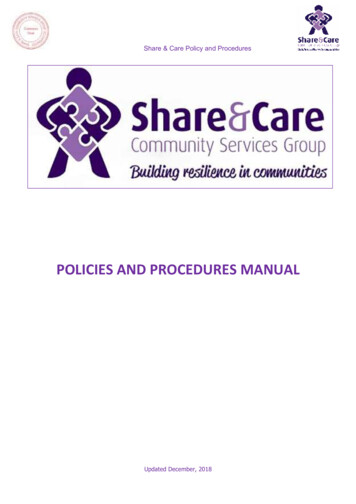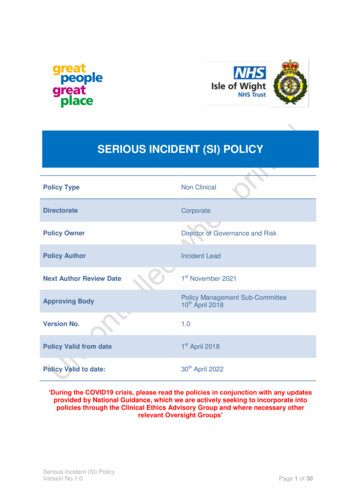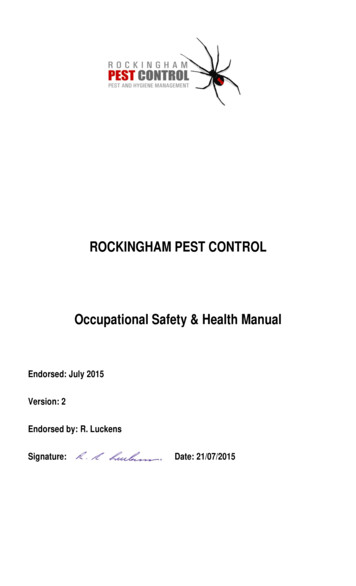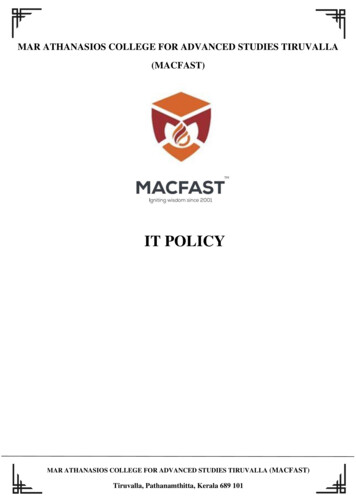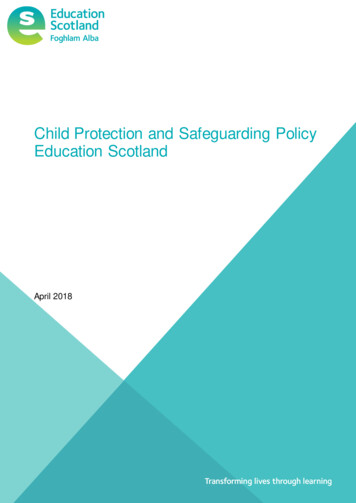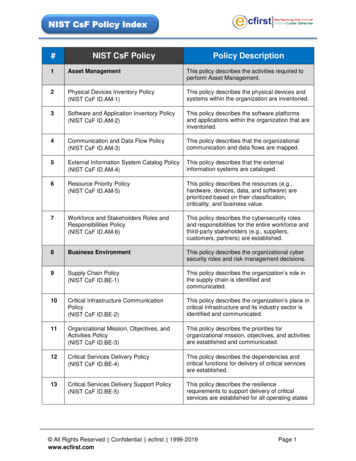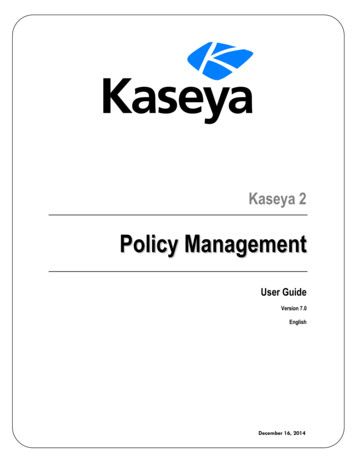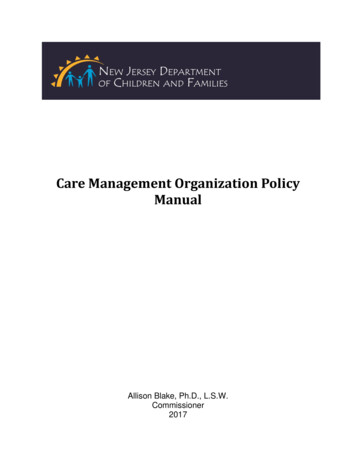
Transcription
Care Management Organization PolicyManualAllison Blake, Ph.D., L.S.W.Commissioner2017
Table of ContentsForewordSection 1: System of Care History and Guiding PrinciplesI. System of Care Historya. System of Care Approachb. Principles of Wraparoundpp.7-9777-9Section 2: Components of the Children’s System of CareI. Contracted System Administrator (CSA)II. Mobile Response and Stabilization Services (MRSS)III. Family Support Organizations (FSO)a. Youth PartnershipsIV. Care Management Organizations (CMO)V. Children’s Inter-Agency Coordinating Council (CIACC)pp.10-1410-1111-1212-1312-131314Section 3: Care Management Organization Program StructureI. The Role of the Care Management Organization in the CommunityII. CMO Executive Leadershipa. Chief ExecutiveIII. Board of Directors: Structure, Formation, and GovernanceIV. CMO Functional Rolesa. Managementi. Operationsii. Financialiii. Community Resource Developmentiv. Quality Assessment/Performance Improvementb. Care Managementi. Care Manager Supervisorii. Care Managerc. Clinical Consultant to DCP&Pd. Behavioral Health Home (BHH)i. Nurse Managerii. Health and Wellness CoachV. Other Rolesi. Court Liaisonii. Presumptive Eligibility Coordinator (PE Coordinator)iii. Care Manager Lead/Senior Care Manageriv. Program Managerv. System Coordinator/LiaisonVI. Care Manager CertificationVII. 1Section 4: Access and EligibilityI. Pathways to the Care Management Organizationa. Needs Assessment/Biopsychosocial Assessmentpp.22-3322-2422
b. MRSS Referralc. Existing Clinical Providersd. Court Referrals, including 14 Day Planse. Youth Detention Centersf. Substance Use Assessors/Providersg. Children’s Crisis Intervention Services (CCIS)h. Juvenile Justice Commission (JJC)i. Cross County ReferralsII. CMO Eligibility RequirementsIII. Additional Supports and Services Available to CMO Youtha. Developmental Disability (DD) Eligibilityb. Behavioral Health Homes (BHH)c. Social Emotional Learning (SEL)IV. Coordination of Insurance Coveragea. NJ FamilyCare PE Provider Responsibilitiesi. MLTSS and DDD Waiversb. 3560 Eligibilityc. SED NJFC Eligibilityd. Third Party Liability (TPL)Section 5: Care Management Organization Program ModelI. The Wraparound Modela. System of Care Approachb. The Principles of Wraparoundc. Family Friendly LanguageII. NJ Care Management Processesa. Referral and Engagementb. Initial Face to Face Visiti. Introducing Care Managementii. Family Crisis Planningiii. Interim Planningiv. Wrapping Up the Initial Visitv. Gathering Collateral Contactsc. The Child Family Team (CFT)Processi. Composition of the CFTii. Roles of CFT Membersiii. Activities of the CFTd. Behavioral Health Home Planninge. Transition Planningi. Transition from CMOii. Transitioning to Adulthoodiii. DD Eligible Transition Age Youthf. Documentationi. ISP Documentationii. Release of Informationiii. Plans CMOs Developiv. Plans CMOs Reviewv. Progress Note Documentationvi. Substance Use 050-5151-535353-555556575758
vii. BHH Documentationg. CMO Annual Review and Documentation Process5858Section 6: Supports and Services AvailableI. IntroductionII. Wrap/Flex FundsIII. Community ResourcesIV. Intensive In-Community Services (IIC)V. MultiSystemic Therapy (MST)/Functional Family Therapy (FFT)VI. OutpatientVII. Partial Care (PC), including Intensive Outpatient (IOP)VIII. Partial HospitalizationIX. Boggs Center Technical AssistanceX. Supports and Services Requiring Prior Developmental Disability (DD) Eligibilitya. Family Support Services (FSS)i. Respiteii. Campiii. Assistive Technology Devicesiv. Home and Vehicle Modificationsb. Intensive In-Home Services (IIH)i. IIH Clinical Servicesii. IIH Behavioral Servicesiii. IIH Individual Support Services (ISS)c. DD MCO Care ManagerXI. Substance Use 6565-67666666-676767-706868-6969-707070-72Section 7: Out of Home TreatmentI. IntroductionII. Intensities of Servicea. Behavioral Healthb. Intellectual/Developmental Disabilities (I/DD)c. Stabilization Servicesi. Crisis Stabilization and Assessment Centersii. Urgent Respite Accessiii. Emergency Diagnostic Reception Unit (EDRU)iv. Treatment Home Stabilization Servicesd. Substance Use Co-Occurring Treatment ProgramsIII. Out of Home (OOH) Referral Request Processa. Access to the Specialized Residential Treatment Unit (SRTU)b. IOS Dispute ProcessIV. Coordinating Care for Youth in OOH TreatmentV. Transition from OOH Treatmenta. Transition to Alternate OOH Treatment Settingsb. Transition Due to Special Circumstancesc. Transition to DDD OOH Supportsd. Transition to DMHAS OOH -81808181-8383-8583-848484-8585Section 8: Coordination and Collaboration with System Partners and Otherpp.86-114Entities
I. Children’s Inter-agency Coordinating Council (CIACC)86-87II. In-Home/In-Community Providers (IIC, BA, IIH)87III. Children’s Crisis Intervention Services (CCIS)87-88IV. Intermediate Inpatient Units (IIU)88-89V. Court Systems89-104a. Introduction to New Jersey Superior Court89b. Overview of Juvenile Delinquency Docket89-96c. Overview of Children in Court Docket96-101d. Overview of Civil Commitment Docket101-104VI. Family Crisis Intervention Units (FCIU)104-105VII. Division of Child Protection and Permanency (DCP&P)105-108a. DCP&P Access to Shelters107b. Office of Adolescent Services (OAS)107-108VIII. Screening Centers108IX. Division of Developmental Disabilities (DDD), including DDD Roundtable109Transition ProcessX. Adult Mental Health109-111XI. Educational Systems111-112XII. Early Childhood Systems and Supports112XIII. Traumatic Loss Coalition (TLC)112-113XIV. Division of Vocational Rehabilitation Services (DVRS)113XV. Division of Disability Services (DDS)113-114Section 9: Finance and BillingI. NJ FamilyCare Funding and Billing PracticesII. Contract Funding and Flex Fundingpp.115-116115115-116Section 10: Quality Assessment and Performance ImprovementI. Quality AssessmentII. Measures of Performancea. Data Dashboardsb. Satisfaction Surveysc. Wraparound Fidelity IndexIII. Unusual Incident Reporting (UIR)IV. System Review endicesAppendix A: Family Friendly LanguageAppendix B: Language of the Children’s System of Care (CSOC)Appendix C: Practice Guidelines for CMOs Serving Youth with Intellectual and/orDevelopmental Disabilities and Serious Behavioral ChallengesAppendix D: AcronymsAppendix E: Behavioral Health HomesAppendix F: Working with Youth with Co-Occurring Behavioral Health and SubstanceUse NeedsAppendix G: Children’s System of Care-Flex Funds
ForewordThe Care Management Organizations (CMO) in New Jersey are broadly responsible forcoordinating supports and services for youth with moderate and high needs and their families,ultimately helping them feel better. They are responsible for removing barriers to care andsupporting the development of a sustainable long-term plan that allows youth and families tosucceed in managing their needs by coordinating and accessing supports and services, theyidentify.The New Jersey Department of Children and Families, Division of Children’s System of Care(CSOC) has revised the Care Management Organization Manual to offer minimum standards ofoperation to which CMOs must adhere to and that reflect current CSOC policies and practices inCMO service delivery. Care Management Manual is reflective of best practice and is groundedin the wrap around model and system of care approach.This manual cannot account for every specific situation that will arise during Care Managementservices. However, the underlying premise that Care Management practice upholds the bestinterest of the youth and family as planned for through the child family team (CFT) collectivelycan support any circumstance, including the importance of language.CSOC is grateful to the many local system, technical assistance and state representativepartners that provided language, resources, time and effort into the conceptualization anddevelopment of this manual. This process was a true collaboration.
Section 1: System of Care History and Guiding PrinciplesI. System of Care HistoryChildren’s advocates had long identified a need for fundamental structural reform of NewJersey’s System of Care for child, youth, and young adults (youth) with emotional andbehavioral health needs and their families. Initially, like virtually every other state, a number ofyouth-serving systems, each with its own mandates, perspective, and priorities, hadresponsibility to serve these youth. Youth and families entered services through many differentdoors (child welfare, mental health, juvenile justice, education, and the courts), often with similarneeds for behavioral health and other community support services. The access route generallydefined the problem and the services available. This, in turn, tended to define treatment goalsand objectives based on the mandates and priorities of the specific youth serving system. Theavailable services within these systems were then organized as programs, requiring youth to fitthe program’s structure rather than structuring supports and services to meet the individualneeds of the youth and family.In November 1999, New Jersey was awarded a System of Care grant from the SubstanceAbuse and Mental Health Services Administration (SAMHSA) for Burlington County,establishing the Burlington Partnership.In 2000, New Jersey (NJ) began a major statewide reform initiative to restructure the system fordelivering services to youth with behavioral health needs and their families utilizing a System ofCare approach, coordinated and integrated at the local level, and focused on improvedoutcomes for youth and their families. The NJ Children’s System of Care adopted theWraparound Model using the Child Family Team Process. Wraparound is a team basedplanning process that brings together people from different parts of a family’s life to help familiesreach their goals and vision. Wraparound is characterized by a set of Core Values and guidingPrinciples. The NJ Children’s System of Care is founded on the following Core Values andPrinciples:a. System of Care Approach Family Driven and Youth Guided– Families are engaged as activeparticipants at all levels of planning, organization, and service delivery.Culturally and Linguistically Competent – learning and incorporating theyouth and family’s culture, values, preferences, and interests into theplanning process, including the identified language of the family.Community Based – identifying and utilizing supports that are leastrestrictive, accessible, and sustainable to maintain and strengthen thefamily’s existing community relationships.b. The Principles of Wraparound1.2.Family Voice and ChoiceTeam BasedSection 1: System of Care History and Guiding PrinciplesPage 7
3.4.5.6.7.8.9.10.Natural SupportsCollaborationCommunity BasedCulturally CompetentIndividualizedStrength BasedUnconditionalOutcome BasedThese Principles, including methods of implementation, are described and practiced in the NJWraparound: Values & Principles Training, and are reinforced through supervision.Through the implementation of these Values and Principles, we can ensure that our practicesupports the best possible outcomes. Some of the outcomes that the System of Care strives forand that are supported by this implementation are: Improved emotional stability for our youthYouth remaining in their communitiesReduced OOH lengths of stayReduced acute psychiatric hospitalization readmissionsImproved ability for caregivers to provide stable living environments forour youthImproved educational performance and overall social functioning for ouryouthReduced legal involvement for our youthBy 2006, the System of Care had been fully implemented in every New Jersey County.Recognizing the continued need for improvement within a System of Care is essential as theneed for mental health services by those youth within the child welfare system continuallygrows; NJ’s System of Care (CSOC) has continuously sought to improve services andsupports.1New Jersey is one of the only states whose child welfare reform plan included a statewiderestructuring that resulted in the creation of a specific department to house all youth and familybased structures. The Department of Children and Families (DCF) in July 2006 became the firstcabinet level agency whose mission was devoted exclusively to serve and safeguard the mostvulnerable youth and families in the state.2Included in DCF was the Division of Child Protection and Permanency (DCP&P, formerly knownas DYFS) and the Division of Children’s System of Care (CSOC, formerly known as DCBHS),as well as other divisions and entities. The mandate of CSOC was to serve youth withMcGill,K.,&McGill,S.A .New Jersey Children’s Behavioral Healthcare System: Cross service delivery planning for transitionalpopulation of youth (ages 16 and 18 years). Evaluation and Program Planning (2010), doi:10.1016/ j.evalprogplan.2010.11.0082 McGill,K.,&McGill,S.A .New Jersey Children’s Behavioral Healthcare System: Cross service delivery planning for transitional population of youth(ages 16 and 18 years). Evaluation and Program Planning (2010), doi:10.1016/ j.evalprogplan.2010.11.0081Section 1: System of Care History and Guiding PrinciplesPage 8
emotional and behavioral health care needs and their families. DCP&P’s primary mandate wasinvestigating and protecting youth from abuse and neglect while also working towards securingpermanency for youth without primary caregivers.The creation of DCF resulted in a new DCP&P Practice Model that would ensure better planningand coordination between DCP&P and CSOC. Throughout 2006 and 2007, CSOC continued toseek input through focus groups, public hearings, and an independent assessment from theUniversity of South Florida to address improvements to the system. During 2007 and 2008, andbased upon the major recommendations received, CSOC began the process of implementing athorough plan for these system improvements. As a further evolution of the System of Care,Youth Case Management, which served moderate need youth, and Care Management, whichserved high need youth, were unified to provide streamlined services through a single entity.Further reorganization and realignment of service delivery in DCF began in July 2012. Servicesprovided to youth with developmental disabilities and intellectual disabilities were transferredfrom the NJ Department of Human Services’ Division of Developmental Disabilities (DHS/DDD)into the DCF’s Division of Children’s System of Care (CSOC). Addiction services foradolescents up to age 18,and those ages 18-21 already under the protective supervision of theDivision of Child Protection and Permanency (DCP&P) or receiving behavioral health servicesthrough CSOC, were transferred from the DHS Division of Mental Health and Addiction Services(DMHAS) to DCF.Effective July 1, 2013, DCF’s Contracted System Administrator (see Section 2) beganauthorizing youth who meet specific criteria to receive substance use treatment (SUT) servicesfrom a limited number of providers who are contracted with DCF/CSOC. In January 2014,CSOC expanded adolescent substance use treatment resources to include the South JerseyInitiative (SJI) as well as detoxification services for adolescents.In 2015, SAMHSA awarded DCF a 12 million grant to introduce two trauma-informedinterventions: Six Core Strategies for Reducing Seclusion and Restraint Use, and the NurturedHeart Approach. These strategies were put in place to: reduce the percentage of youth in theSystem of Care who require multiple episodes of out-of-home treatment; reduce the percentageof youth who re-enter treatment after transition from an initial treatment episode; reduce theaverage length of stay for youth in out-of-home treatment; and, analyze and understand theimpact of each type of system investment in order to make future resource allocation decisions.The Concept Paper that served as a basis for the beginning of the NJ Children’s System ofCare is available drens.Initiative.Concept.Paper.pdfSection 1: System of Care History and Guiding PrinciplesPage 9
Section 2: Components of the Children’s System of CareThe Children’s System of Care includes a broad array of services to support the needs of youthwith behavioral health, substance use, and intellectual/developmental challenges. All supportsand services offered through CSOC are grounded in System of Care approach and are drivenby the values and principles of Wraparound. All services within CSOC are voluntary and requireparent/guardian consent. Youth under 18 years of age are not required to provide writtenconsent, although engagement of youth in the services is necessary for a successfulintervention.I. Contracted System Administrator (CSA)The CSA serves as the single point of access to services for NJ youth up to age 21 (18 forcertain substance use services) with behavioral, emotional, intellectual, developmental, and/orsubstance use needs. The CSA connects youth and their families with the care they need at theright intensity of treatment.The CSA also facilitates and supports utilization management (including service planning), carecoordination, quality management, and information management for the statewide system ofcare. In this administrative support role, it provides DCF, the CMO, and other system partnerswith the information needed to manage the care planning process toward quality outcomes andcost effective treatment. They are also responsible for housing and maintaining the electronichealth record (EHR) for each youth served by CSOC.Access to Services: The Triage ProcessThe CSA maintains a toll free statewide number that families may call to access NJ CSOCServices. Upon contact from a family, the CSA will complete a registration process duringwhich a youth’s information will be entered into the CSOC’s EHR. The family will speak with aCare Coordinator who is a licensed clinician. The Care Coordinator will obtain information fromthe family to assist in identifying the right path to meet a youth and family’s needs.If the CSA is called in an emergency, the caller will be connected directly with a trained clinician.That person will ask questions to best determine how to help. A behavioral emergency is anyserious behavior on the part of a youth that, if not dealt with right away, could lead to the youthor someone else being harmed. Depending on the emergency, the caller may be referred totheir local hospital psychiatric screening center, or, in a serious emergency, the caller will bedirected to reach emergency personnel by calling 9-1-1. If the youth is screened at anemergency room or is hospitalized, the caller or the youth’s treatment team can request othersupports from the CSA to help when the immediate emergency is over.In urgent behavioral situations (where a person’s immediate safety is not at risk but a youth’sbehavior is escalating beyond a parent or caregiver’s ability to manage it), families areconnected to their local Mobile Response and Stabilization Services (MRSS) provider. MRSSSection 2: Components of the Children’s System of CarePage 10
responds to the crisis in person, within one hour from the family’s call to the CSA. See belowfor more details on the services provided by MRSS.In situations where there is a need for more information than can be collected over the phone inorder to make an accurate assessment of the youth’s needs and the most appropriateresources or services to offer, the CSA will authorize a Needs Assessment and Biopsychosocialevaluation (Needs/BPS) by a licensed Intensive In-Community (IIC) provider. See Section 6 formore information on IIC services.For more information on the current CSA, see http://www.performcarenj.org/about/index.aspx .A Youth and Family Guide to CSOC and the CSA is available in English online family-guide-eng.pdf e-span.pdf .onlineatII. Mobile Response and Stabilization Services (MRSS)MRSS is the CSOC’s urgent response service designed to assist in stabilizing youth in theirhome and community settings. MRSS provides immediate intervention to assist youth and theircaregivers in de-escalating behaviors, emotions, and/or dynamics impacting youth lifefunctioning. Interventions are designed to minimize risk, maintain the youth in his/her currentliving arrangement, prevent repeated hospitalizations, stabilize behavioral health needs, andimprove functioning in life domains. MRSS is available 24 hours a day, seven days a weekwithin an hour of a family’s request to help youth who are experiencing emotional or behavioralcrises. NJ relies on a family’s definition of a crisis as the standard for defining what constitutesa crisis and thus precipitates an offer for MRSS services. The MRSS initial dispatch offers faceto-face service delivery to families in the community at the site of the escalating behavior,whether this is the youth’s home or another living arrangement, including resource and fosterfamily homes. The initial phase of MRSS can extend for up to 72 hours after the dispatchrequest and includes de-escalation, assessment, and crisis planning services with a focus onyouth and family engagement. The Crisis Assessment Tool (CAT) is completed based on theassessment to inform a comprehensive Individualized Crisis Plan (ICP).Based on the youth and family’s needs following the 72 hour initial response, MRSS mayremain involved with the child and family for up to eight weeks of stabilization management,during which time MRSS staff will coordinate formal and informal services for the youth andfamily. MRSS staff will work with the youth and family during this time to ensure a propertransition plan is in place at the end of the youth and family’s stabilization period.Service areas in New Jersey may choose to operate a Combined MRSS-FCIU program, whichfollows the MRSS program model and comports with the FCIU statutes and standards. Moreinformation on FCIU is available in Section 8.Section 2: Components of the Children’s System of CarePage 11
ks.pdfatandIII. Family Support Organizations (FSO)FSOs are nonprofit, county based organizations run by families of youth with emotional,behavioral, developmental, and/or substance use challenges who have received services fromany youth serving system. FSOs allow caregivers to benefit from the guidance and support ofother caregivers with similar experiences. FSOs provide direct family-to-family peer support,education, advocacy, and other supports to caregivers of these youth in partnership with theCMO. To access services, families may call these organizations directly or call the CSA.Caregivers of youth involved with the CMO have access to a one-on-one certified Peer SupportPartner who will help them navigate the System of Care, school system, DCP&P, and the legalsystem. Peer Support Partners are certified through the State of New Jersey’s approvedcurriculum. Peer Support Partners are also available to provide moral support as needed. TheFSO assists families in identifying and accessing sustainable natural supports in theircommunities. Caregivers are empowered to be active, informed, and strong advocates for theiryouth. The FSO engages families in the community, helping them to identify their strengths andbuilding on those strengths to address their needs and goals.Both caregivers of youth involved in the CMO and youth with emotional and behavioral needswho are not involved with the CMO are offered a variety of supports and services, including, butnot limited to:1.2.3.4.5.Warmline during business hoursSupport groupsEducational workshopsYouth PartnershipsSystem nj.gov/dcf/families/support/support .informationisavailableata. Youth PartnershipsYouth Partnerships are peer support groups for youth affiliated with each FSO. They provide avariety of local events and opportunities for teens and young adults with behavioral healthchallenges, whether or not they have been involved in CSOC services. Youth Partnerships helpyouth develop self-advocacy and leadership skills, and work to reduce the stigma attached tohaving a behavioral health challenge or diagnosis. Meetings often occur weekly or monthly,depending on the service area.Section 2: Components of the Children’s System of CarePage 12
Youth Partnerships statewide met with CSOC to develop standards around youth voice insystem development and service delivery. In 2008, the Youth Guiding Document was l/YCguidingdoc10 28 09.pdfAdditional youth development resources are available at http://www.nj.gov/dcf/providers/csc/.IV. Care Management Organizations (CMO)CMOs are county based, nonprofit organizations that are responsible for face-to-face caremanagement and comprehensive service planning for youth and their families with intenseand/or complex needs. They coordinate Child Family Team (CFT) meetings, and implementIndividual Service Plans (ISP) for each youth and his/her family. They coordinate the delivery ofservices and supports needed to maintain stability and progress towards goals for each youth,utilizing a Wraparound approach to planning.The CMO’s role is to help families to feel better by developing a plan to address their needs andremoving barriers that may impede progress. Their goal is to help youth and families develop along term, sustainable plan that will support them in improved functioning long after CMOinvolvement. The CFT does anything necessary to remove barriers to care, drive care in theSOC approach, and facilitate creative, flexible planning to support the family and youth.Initial CMO services include, but are not limited to:1. Engagement of the youth and family into CMO services2. Initiate development of Child Family Team including collaboration with FSO3. Development of a Family Crisis Plan to stabilize the youth and address the immediateconcerns of the youth and familyContinuing CMO services include, but are not limited to:1.2.3.4.Comprehensive assessment servicesISP design and implementationAdvocacy and family supportMonitoring, Information management and improvementIn addition to the above, CMOs are the designated Behavioral Health Home (BHH) entities foryouth in New Jersey. BHHs serve as a “bridge” that connects prevention, primary care, andspecialty care, and is designed to avoid fragmented care that leads to unnecessary use of highend services.The BHH Core Team, which includes medical and health/wellness expertise, builds on thecurrent CMO array of staff with the intent to provide a holistic approach to care for children.This expanded team constitutes the services of the BHH and will broaden the current CMO carecoordination and care management functions to include the ability to identify, screen andcoordinate both primary care and specialty medical care.Section 2: Components of the Children’s System of CarePage 13
V. Children’s Inter-Agency Coordinating Councils (CIACC)CIACCs are local planning bodies that foster cross-system service planning for youth withbehavioral health needs. CIACCs provide a multidisciplinary forum to develop and maintain aresponsive, accessible, and integrated System of Care for youth with social, behavioral,developmental, substance use, and/or emotional needs and their families, through theinvolvement of families, youth, natural family supports, and youth serving agencies as partners.CIACCs serve in an advisory capacity to both county government and DCF in planning forservices for youth. They are facilitated by a local CIACC Convener funded through CSOC, andtheir membership includes families, local system partners (including CMOs), community basedorganizations, county planning entities, and state representatives. They identify needs andaddress barriers to effective service delivery, and make appropriate recommendations onprograms and policies to ensure a comprehensive system of needed services within the countyis maintained. They also participate in ongoing DCF quality assurance pdf /providers/resources/interagency/ .atisavailableSee Section 8 for more information on coordination with CIACCs and other system partners.Section 2: Components of the Children’s System of CarePage 14
Section 3: Care Management Organization StructureI. The Role of the Care Management Organization in the CommunityCSOC established and funded CMO agencies statewide to coordinate care for youth withmoderate to high, complex needs and their families to support youth in remaining at home, inschool, and in the community. CMOs contracts were awarded through a Request for Proposalprocess and are governed by regulations, which can be found at N.J.A.C. 10:73 Subchapter 3.CMOs are the single point of organizational accountability for developing the local system ofcare necessary to support need based intervention and achieve desired outcomes for youth withbehavioral health, developmental, or substance use challenges, whose ties to home andcommunity are threatened. CMOs must demonstrate commitment and capacity to organize aneffective system of care at the community level tha
Section 3: Care Management Organization Program Structure pp.15-21 I. The Role of the Care Management Organization in the Community 15 II. CMO Executive Leadership 15-16 a. Chief Executive 15-16 III. Board of Directors: Structure, Formation, and Governance 16-17 IV. CMO Functional Roles 17-20 a. Management 17-18 i. Operations 17 ii. Financial 17

